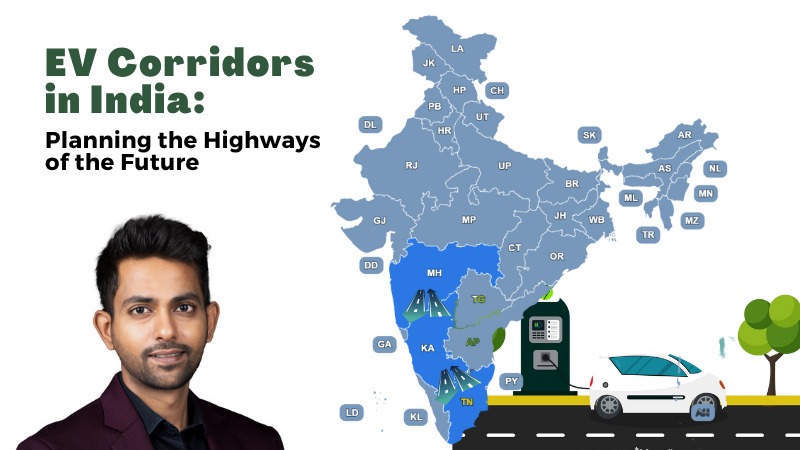EV Corridors in India: Planning the Highways of the Future
India’s EV corridors, equipped with high-speed DC fast chargers, are enabling long-distance electric travel and supporting fleet electrification. This article, by Raghav Bharadwaj, CEO & Founder of Bolt.Earth, explores their planning, technology, and future impact on sustainable mobility.
As India accelerates its transition to electric mobility, Electric Vehicle (EV) corridors are becoming a pivotal strategy to support long-distance travel infrastructure. These corridors, equipped with high-speed DC fast chargers, aim to reduce range anxiety, facilitate efficient EV adoption, and integrate electric transportation into the nation’s broader mobility ecosystem.
Understanding DC Fast Chargers
DC fast chargers, also known as Level 3 chargers, deliver direct current directly to an EV’s battery, bypassing the vehicle’s onboard AC-to-DC converter. This allows significantly faster charging compared to standard AC chargers (Level 1 or 2).
- Power Output: DC fast chargers typically range from 30 kW to over 300 kW, depending on vehicle and station capabilities.
- Charging Speed: Most EVs can reach 80% charge in 15–45 minutes, enabling long-distance travel with minimal stops.
- Use Case: Ideal for public use, fleet operations, highway rest stops, and urban hubs, making them essential for both personal and commercial EV adoption.
These chargers form the backbone of EV corridors, ensuring that long trips across India’s highways are feasible and convenient. However, they are primarily designed for commercial and public use, rather than home installations. DC fast charging stations require robust infrastructure, including high-capacity grid connections, heavy-duty cabling, advanced cooling systems, and strict safety protocols. While significantly more expensive than home chargers, their ability to recharge an EV in a fraction of the time makes them indispensable for long-distance travel, fleet operations, and scenarios where rapid charging is critical.
That said, convenience comes at a price. DC fast charging tends to be significantly more expensive than residential power on a per-kWh basis. Operators must cover high installation and electricity demand costs, so drivers pay a premium for speed. In some regions, a full charge on a public DC station might cost 3–4 times more than charging the same amount at home. As a result, urban fast chargers are often used sparingly or for “top-ups” rather than as a primary energy source. Despite the cost, their availability is crucial, especially for drivers without home charging and for relieving congestion at slower AC charging stations.
The Rise of Highway EV Corridors
India’s EV corridor initiative is guided by the National Electric Mobility Mission and reinforced by state-level policies. The goal is to establish strategically placed fast-charging stations along major highways, enabling seamless intercity travel for electric vehicle owners. (Press Information Bureau).
Key Features of Highway EV Corridors:
1. Station Spacing: Government guidelines recommend at least one charging station every 25 km on highways, depending on traffic density and highway length. (Ministry of Power, PDF).
2. Amenities: Highway chargers are often integrated with amenities like restrooms, food courts, and convenience stores, similar to conventional fuel stations.
3. Fleet Support: Fast chargers are compatible with commercial EVs, including buses, trucks, and three-wheelers, enabling public and freight transport to transition to electric power.
Case Example: The Mumbai-Pune Expressway has already seen pilot installations of DC fast chargers, reducing travel downtime for EV users and demonstrating the viability of long-distance electric mobility.
Highway EV corridors also draw inspiration from international examples such as the West Coast Electric Highway in the US and Europe’s Alternative Fuels Infrastructure Regulation (AFIR) network, where fast-charging stations are strategically placed to support uninterrupted travel across regions.
As of mid-2025, the global network of public EV charging stations has expanded significantly. China leads the world with approximately 16.7 million charging points, accounting for about 65% of the global total. The United States follows with around 195,874 public charging ports across 69,679 stations. In Europe, the number of public charging points grew more than 35% in 2024 compared to 2023, reaching just over 1 million.
Highway chargers, often with multiple high-power ports, reduce wait times and make long-distance EV travel more convenient, highlighting the importance of a reliable public charging network to ease range anxiety.
Policy Support and Industry Collaboration
The rapid development of EV corridors is backed by proactive government policies and industry collaboration:
1. PM E-Drive Scheme (October 1, 2024–March 31, 2026): India’s flagship electric mobility initiative, the PM Electric Drive Revolution in Innovative Vehicle Enhancement (PM E-DRIVE) scheme, has a total outlay of ₹10,900 crore.
It aims to accelerate EV adoption and strengthen the national EV ecosystem through two primary objectives:
- Demand-side incentives for buyers of electric vehicles
- Expansion of EV charging infrastructure across the country
To scale up public EV charging stations, ₹2,000 crore is allocated under this program with a plan to install approximately 72,000 chargers across 50 national highway corridors and high-footfall public locations by FY 2025–26.
2. Public-Private Partnerships: Oil marketing companies (IOCL, BPCL, HPCL) are collaborating with automobile manufacturers and startups to deploy one of India’s largest networks of interoperable public chargers.
3. State Policies:States like Tamil Nadu and Maharashtra have dedicated incentives for setting up fast chargers along highways and urban centers.
4. Standardization: Government regulations promote standardized connectors and billing systems, ensuring seamless interoperability across EV models and charger operators.
Key Safety Features in Commercial DC Fast Chargers
- Ground Fault Detection: Residual current monitoring (GFCI/RCD) cuts power instantly if current leakage to ground is detected, preventing electric shocks.
- Overcurrent & Surge Protection: Built-in fuses or breakers disconnect power during short circuits, overloads, or voltage spikes to avoid fires or equipment damage.
- Thermal Management: Sensors monitor internal temperatures and activate cooling or shutdown to prevent overheating and fire risks.
- Emergency Stop Button: A clearly marked EMERGENCY STOP switch allows users to cut all power output immediately during malfunction or danger.
- Insulation Monitoring: Continuously checks high-voltage insulation; halts charging if faults are detected to ensure user safety.
- Standards Compliance: Certifications such as ARAI, UL, CE, or IEC 61851 confirm adherence to global safety and performance standards.
Technological Innovations Shaping the Future
Technological advancements are making next-generation fast chargers more powerful and more grid-friendly. Some stations now even exceed 350 kW, and future models may push charging times closer to the single-digit minutes.
EV corridors are not just about placing chargers—they are also leveraging cutting-edge technologies:
- AI & IoT Integration: Smart charging stations can manage grid load, predict peak demand, and optimize charging schedules.
- Battery Swapping: Some corridors are exploring battery swapping stations for commercial vehicles, reducing downtime and increasing fleet efficiency.
- Renewable Integration: Several fast-charging stations are being paired with solar PV panels and energy storage systems to reduce grid dependency and carbon footprint.
The Road Ahead
By 2040, India aims to have a dense, nationwide network of EV corridors connecting metro cities, towns, and rural regions. Key projections include:
- Widespread Coverage: Nearly all national highways and expressways will feature DC fast chargers.
- Fleet Electrification: Logistics and public transport sectors will increasingly rely on electric vehicles, supported by high-speed corridors.
- Smart Charging Networks: AI-enabled chargers will provide real-time data to drivers, fleet managers, and grid operators, optimizing usage and reducing wait times.
- Investment Flow: Both domestic and global investors are expected to play a significant role in expanding infrastructure, making EVs a practical option for all income segments.
Conclusion
The establishment of EV corridors equipped with DC fast chargers is a critical step towards realizing a sustainable and electrified transportation future in India. Through strategic planning, policy support, and industry collaboration, these corridors are transforming highways into pathways for clean mobility, ensuring that electric vehicles are a practical and accessible option for all.
As the nation continues to invest in and develop these corridors, the vision of a fully electrified transportation network becomes increasingly attainable, paving the way for a greener and more sustainable future.
Also Read: Charging solutions provider Bolt.Earth secures $20 million investment
Subscribe today for free and stay on top of latest developments in EV domain.





